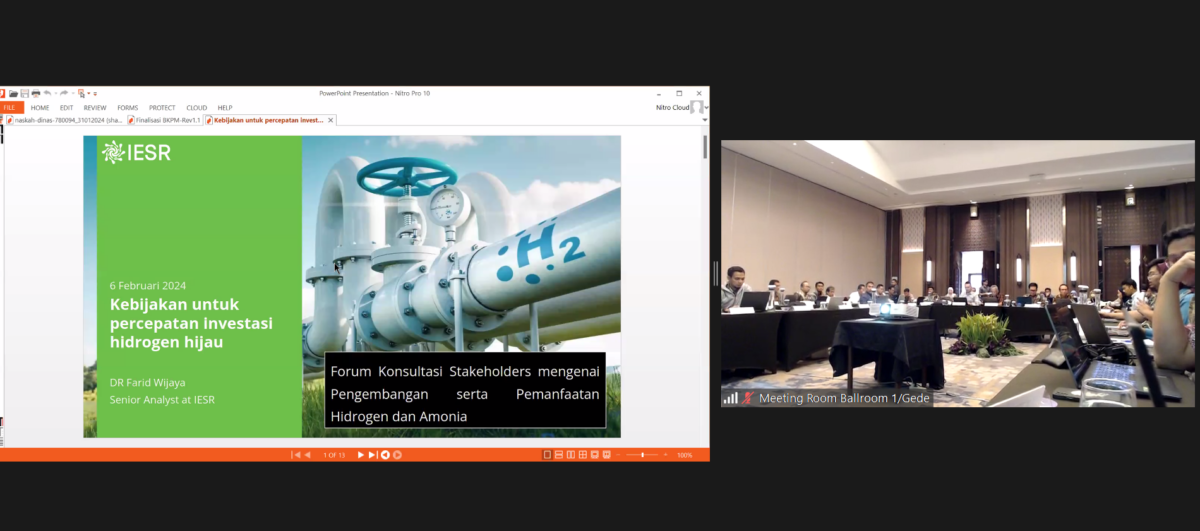Executive Director of the Institute for Essential Services Reform (IESR) Fabby Tumiwa said that optimizing the development of Solar Power Plants (Solar PV) could contribute to achieving 23 percent of the energy mix in 2025.
Read more on Medcom.
The plan to reduce the renewable energy target contained in the Draft Government Regulation or National Energy Policy RPP is considered realistic. However, as a consequence, the peak greenhouse gas emissions target could be pushed back.
Read more on Kompas.

Bogor, February 6, 2024 - In facing the increasingly urgent challenge of climate change, one of the crucial steps that must be taken is to accelerate investment in clean energy technologies. One of the most prominent recent innovations is the development of green hydrogen. Based on data from the Ministry of Energy and Mineral Resources…
Since morning, several trucks filled with garbage have entered the area of the Red and White Waste Power Plant (PLTSa) in Bantargebang, Bekasi, West Java. Here, the waste will be processed into electricity.
Read more on KBR.
Who would have thought that cow dung, which is often considered inferior because it gives off an unpleasant aroma, could be transformed into biogas. Karya Nugraha Jaya Cooperation in Kuningan has successfully utilized cow dung into biogas which is used as production fuel.
Read more on Kompas.com.

Bandung, January 25, 2024 - Indonesia is blessed with abundant natural resources and committed to achieving the Net Zero Emission (NZE) target by 2060 or earlier. The industrial sector is crucial in this energy transition towards a sustainable future. Based on data from the Ministry of Industry (MoI), greenhouse gas (GHG) emissions from the industrial…

Jakarta, February 2, 2024 - Indonesia, under the coordination of the Ministry of Environment and Forestry (MoEF), has initiated the drafting process for its Second National Determined Contribution (SNDC) aimed at emissions reductions by 2030 and 2035. The MoEF intends to submit the SNDC to the UNFCCC in 2024.
The Institute for Essential Services Reform…

Bandung, January 24, 2024 - Renewable energy promotes sustainability and minimizes environmental impacts. In West Java, Indonesia, there is a growing focus on increasing the usage of renewable energy. According to the Energy and Mineral Resources Agency (ESDM) of West Java Province, the region has a renewable energy potential of 192 GW (gigawatts).
The West…

Jakarta, 30 January 2024 - The World Meteorological Organization (WMO) has declared 2023 as the hottest year. Historical records show that the earth's temperature continues to increase from year to year. To keep the earth's temperature rise to no more than 1.5 degrees, experts have recommended ensuring the world reaches peak global emissions in 2030…

Cirebon, 26 January 2024 - On the fourth day, the West Java Energy Exploration team continued their journey to Cirebon. Precisely in South Kesunean, Kasepuhan Village, Lemahwungkuk District. There, the group moved towards the shoreline to plant mangroves. South Kesunean has one problem, namely the emerging soil phenomenon. This raised land appears due to the…
The government's plan to revise the renewable energy target from 23% to 17-19% by 2025 is considered inappropriate. The Civil Society Coalition for Energy urges the government to evaluate the causes of failure to achieve the target.
Read more on Media Indonesia.
Combining solar and hydropower plants in one area can stabilize the electricity supply. Such is the case in Cirata's floating solar and hydropower plant.
Read more on KBR.
